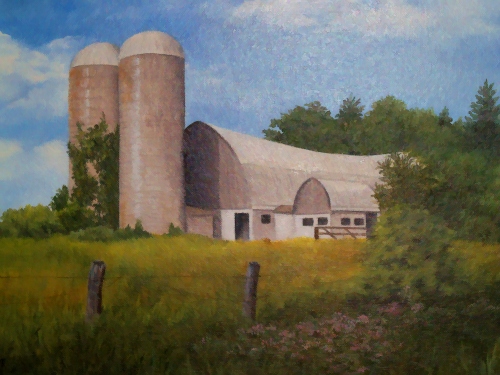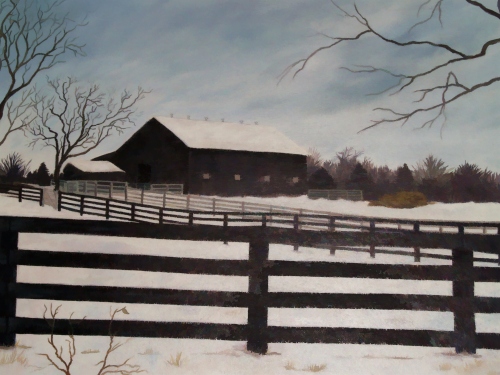Oldham County Fun Fact #4
Oldham County Fun Fact #4
“In the 1940’s and 1950’s, Oldham County was one of the leading dairy counties in the state of Kentucky. In some way, almost every family was tied to a dairy farm through production or manufacturing.”
The Barn Painter of Oldham County:
Ann Carter’s Art Has a Story to Tell
Original Article By Helen E. McKinney
Growing up in a rural southern Iowa town, Ann Carter was keenly aware of farming communities and their dependence on barns. She believes that whether new or old, freshly painted or worm-eaten and weathered, each barn has a story of its own to tell.
Carter often preserves on canvas her childhood memories of growing up on a farm in Corydon, Wayne County, Iowa. “My dad was a carpenter and he built barns,” said Carter, 77. “I think that when you live in an area where there is farmland, it creates an interest.”
She and her late husband, an engineer for General Electric, moved to Kentucky for his job. The couple also lived in Maryland, where many of Carter’s commissioned paintings hang in the homes of individuals who enjoy her work and the peaceful mood it evokes. Her oil paintings are owned by people living in Kansas, Minnesota, Ohio, Tennessee and several Kentucky counties as well.
In 1975, Carter moved to Oldham County. “When I came here barns were falling down or being torn down.” Carter regrets this because “barns have a story to tell. They have a history.”
Such as the story behind her painting of “Barns of Blakemore Farm.” Carter recreated two of the six barns on Bob Blakemore’s 200-acre farm. This farm has remained in the same family for three generations. The barn builder who did most of the work, Richard Bergen, had only one leg.
The dairy barn (on right in painting) was used for dairy purposes until 1942 when it became a beef cattle barn. The other barn (on the left) was built for horses on one side and as a feed barn for cattle on the other, with a hayloft above.
“A Swayback Beauty” was on a farm in Oldham County originally owned by Mr. Spann. Lumber for the barn, which is still standing, came from the 700-acre farm. The property was divided when Interstate 71 was built.

A Swayback Beauty
For Carter, paining has always been “just part of my life.” Her mother was also a painter and encouraged Carter as much as she could. Carter took commercial art training by attending Art Instruction, Inc., and fine-toned her skills locally at the Louisville School of Art and Jefferson Community College. At the latter institution, Carter said she was asked to run the airbrush room and then the photography lab.
“When I came to Oldham County in 1975 and saw roads began to widen, bridges go from one lane to two and barns sitting unused, it saddened me,” said Carter. A part of the lifestyle of my childhood was disappearing. Later, when those barns began coming down it seemed only natural for me to want to preserve them on canvas.”
With her very first showing of paintings in Oldham County, she “found that folks in Oldham County had the same deep desire,” as she to preserve their barn heritage because “the first paining I sold was a painting of an Oldham County barn. That sale, along with my own memories and love of barns and farm life, influenced me to make barn paintings my specialty.”
Carter said that, “a part of me is in every painting I complete. I feel I have a God-given talent and I’m just sharing it with the world. If my talent can make someone enjoy life a little more, then I’m happier too.”
Due to development and harsh weather, there are fewer and fewer barns left standing in Oldham County than there were a century ago. In their heyday, barns had many functions: milking parlors, horse stables, tobacco curing, grain storage, cattle and hog shelters, just to name a few. “The ones that are left symbolize the fact that this was a farming community in the past,” she said.
In the 1940’s and 1950’s, Oldham County was one of the leading dairy counties in the state of Kentucky. In some way, almost every family was tied to a dairy farm through production or manufacturing.
One of the most recognizable barns in Oldham County lies along Hwy. 53 north of La Grange. The old Hampton barn was built between 1913-1919, and used as a dairy barn until the new Hwy. 53 came through and divided the farm. After that, the Hampton family gave up dairying.
One of its most noticeable features is the accompanying silo. Silos are a more recent addition, developed around 1860; the vast majority of silos were built throughout the 1880s. The Hampton silo was constructed of tile, giving it a unique look. The silo has a twin located on Hwy. 42 on the Norman Dick farm.
The salesman who sold the Hamptons the brick tile for their silo sent enough for two silos the day it was constructed. Since Hampton only wanted one silo, the deliveryman had to get rid of the extra tile some way. Dick bought it, and both silos are still standing. Carter also has a painting for sale entitled, “Norman Dick Tobacco Barn.”
Many families from Lancaster County, Pa., settled in Oldham County and brought their barn building techniques with them. Amish, German and Swiss immigrants built several barns in the county as well. The last two groups were notable for the bank barns they built. Examples of such barns still standing within the county are the Gheens Barn at Yew Dell Botanical Gardens in Crestwood and the Mahan-Oldham County Public Library in Goshen.
One of Carter’s newest paintings is of the Asbourne Cattle Barn from the farm off of Hwy 53. Carter said that Nancy Theiss, Executive Director of the Oldham County History Center, asked her to create the painting to accompany a display at the history center. “It was great fun being out there on the farm and painting the barn,” said Carter.
As a credit to her success, she was asked to do a showing of her artwork in her native town of Corydon, Iowa. Carter was asked to be the grand marshal of a parade and give the speech of the day for the town’s Old Settler’s Day, she said. In all, she has probably painted over 100 barn scenes.
Carter has different sized paintings for sale at different prices. She is “willing to paint for people if they ask me,” she said. It excites her when “they let me come on the property and ask questions. There is always a story to tell.” For her, “realism and detail are important to me. I hope I am preserving a bit of the past.”
Just as the barns themselves were once commonplace, few now stand as examples of our culture. The remaining ones evoke a sense of tradition, closeness to the land, family life and a link to our rapidly fading rural past.
For more information about Carter’s work or to contact her to commission a painting, email her at arcarter16@bellsouth.net or call her at (502) 241-4152. Her work will hang at the Oldham County History Center located at 106 North Second Ave. in La Grange throughout the end of 2011

Roederer Farm Complex
Probably built ca. 1940; known as “killer barn” at Reformatory in Buckner; barn area held feed lot where cattle were finished out for slaughter

